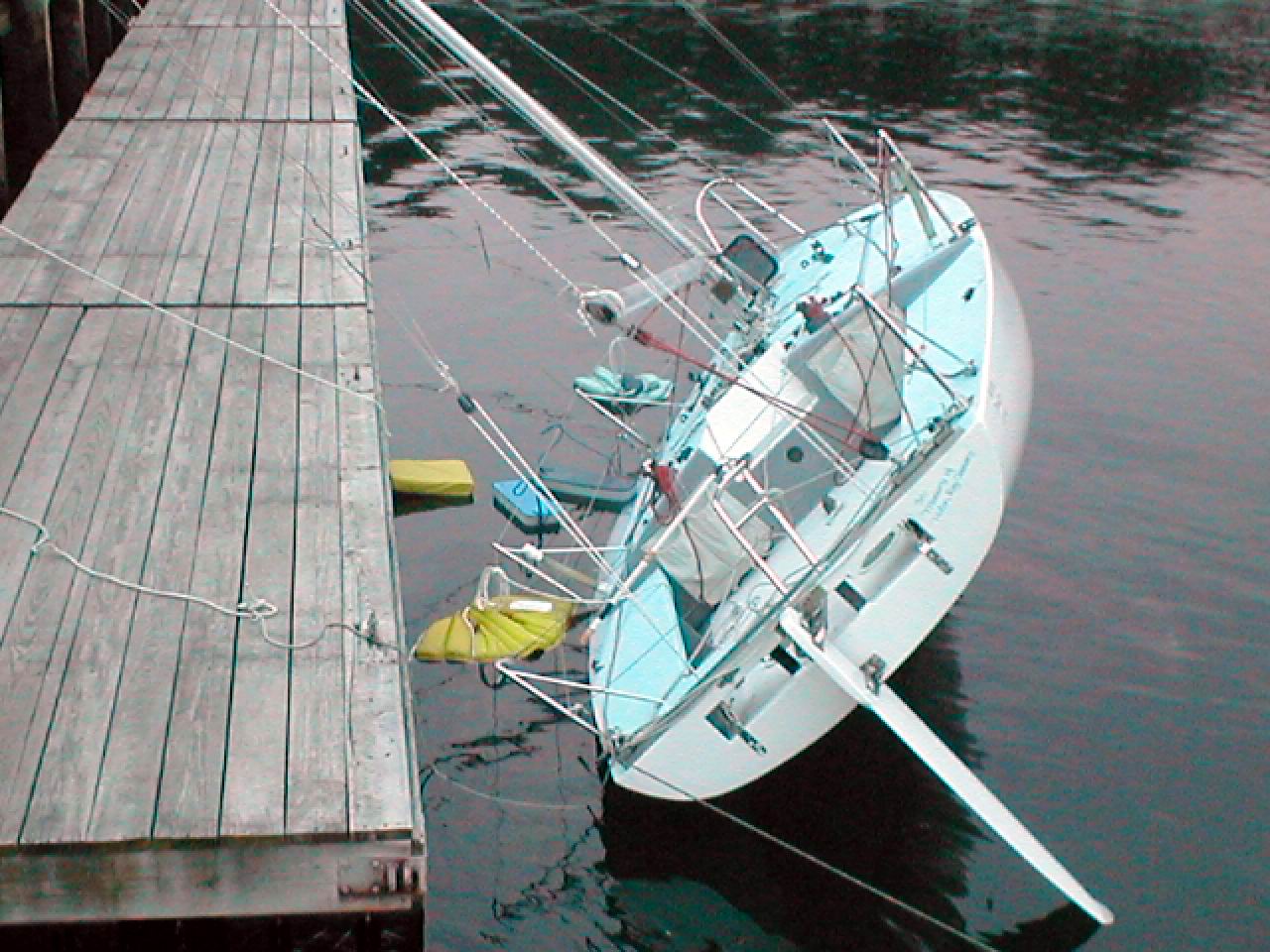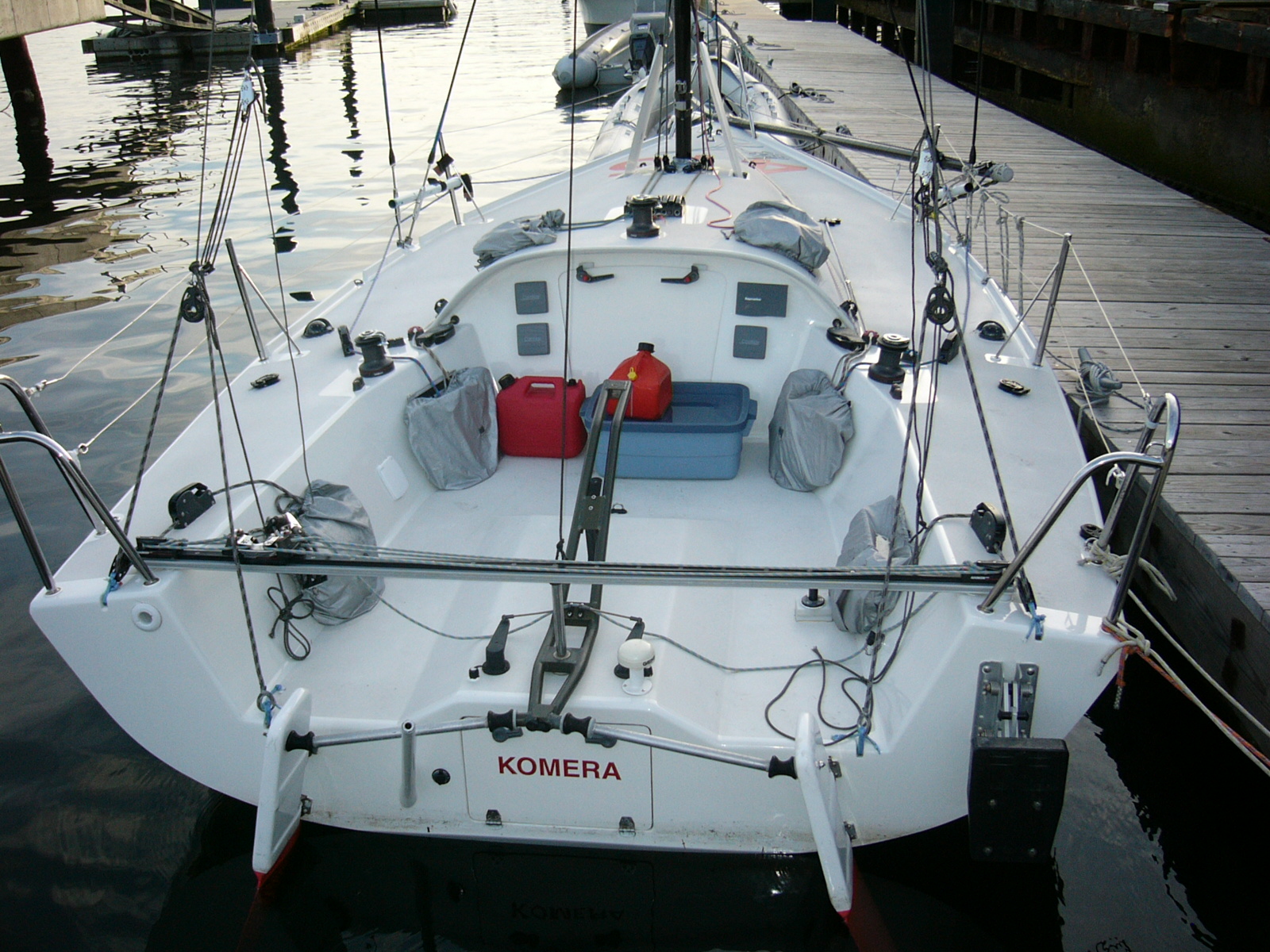For an admittedly small cohort of US sailors, it is relatively easy to understand the French passion for fast, short handed (solo or double handed) offshore sailing. For those of us who do relate to such events, two of the bigger ones, the Transat Jacques Vabre and The Mini Transat are both now fully underway. These races offer a couple or three weeks of the finest examples of this division of the sport of sailing.
One of the continuing fascinations for me is the skill these guys and girls have and the thought that goes into making them, the crews and the boats sufficiently safe so that there is a reasonable chance they will all finish in one piece. For instance all the Mini skippers have to carry an immersion suit. They are required to have a water tight bulkhead in the bow and they must have sufficient built in flotation to keep the boat afloat in the event of a holing. Minis were among the first class’s to have escape hatches in the stern. The qualifying process in terms of miles sailed and races completed is very rigorous in order to be accepted as an entry in the Mini Transat. Compare that with the entry requirements for most ocean races in the US. The only races I can think of right now that actually mandate qualifications and a qualifying passage are the Bermuda 1-2 and the Single handed Transpac.
One significant requirement that the Mini’s started and now is incorporated into the Class 40’s and the IMOCA 60’s is the stability test. For the Mini’s they must be capsized at the dock, the mast head at 90 degrees to the water plane, a weight put a roughly 50 Kg. weight on the top of the spar and the boat must recover from this position or it does not pass.
All sailors and cruising sailors in particular can always benefit from the practice of important skills: MOB, broken equipment and so I think there is a lot to be learned from the world of the single and double handed races that the average cruising sailor could benefit from in terms of practice and forward planning. Anyway, read on:
As it turns out, after being in postponement mode for two weeks waiting for it to stop blowing the labels off the wine bottles on the Brittany Coast, the Mini Transat race started 29 October last. A day or two later with the boats Half way across the Bay of Biscay, the race committee abandoned the race and instructed the fleet to beat feet to the closest port based on the forecast that it was to blow like stink again. 5 boats made it to Sada on the NW coast of Spain while the rest blew into Gijon further to the east. A couple more were further east and one, the sole US boat sailed by Jeff MacFarlane, drifted off downwind after he broke the rig and was lifted off by one of the escort boats. Jeff must be pretty hard on his boats: this is the second one he has broken in two years trying to keep his position as the number three ranked mini sailor in the world.

You are single handed on the boat, but no one does these things alone. Image (c) Don Miller Photography 1995.
The Mini’s are 21 foot rockets sailed solo From France, with a scheduled stop in The Canaries, which for this year has been abandoned due to the weather delays in favor of merely passing through a gate adjacent to The Canaries, then full blast across the Atlantic finishing in Guadeloupe.
The 4 classes of boats in the TJV, a trans-Atlantic race sailed double handed from France to Itajai, a coastal city south of Rio in Brazil (and a repeat stop over port for the 2015 VOR) are class 40’s, IMOCA 60’s, 50 foot multi-hulls and 2 MOD Tri’s (sailed double handed at 25-30 knots most of the time) were also held for a few days due to 50 knots of gale blowing across the basin in Le Havre the starting point for the TJV. This fleet got off last Saturday or Sunday but shortly after the start the race committee instructed the Class 40’s to finish at Roscoff, about 200 miles SW down the track from Le Havre. Reason being yet another 50 knot gale about to blow across the Bay of Biscay and the 40’s were not going to be fast enough to get far enough south to avoid it. The idea of beating up wind in 45-55 knots in a Class 40 is less than appealing, even to the French.

A class 40. One of the impressive features of these true offshore boats is the really properly water tight hatch into the cabin seen here with the hatch handles and a bar (for the padlock) on it
While the Minis had a week in Spain the remaining three classes of the TJV boats sailed

An attribute of the Mini Class is the, if not regulation requirement that you be able to sail with no mast…But given he spirit & history of the race, the boats, the competitors and the events, all of them, encourage the kinds of problem solving & seamanship skills we all ought to aspire too.
past C. Finisterre and the 40’s restarted based on the time differences recorded when they “finished” in Roscoff. On Tuesday the Mini’s started again and headed south down the Spanish/ Portuguese coast in the now 30 knot NE trades. This has interestingly enough put them right on the heels of the Class 40’s the tail-enders, 3 of whom were passing C. Finisterre as the minis came out of the bay on which Gijon is sited.
As it turns out the lead mini has sailed past all three of the tail end Class 40’s. The third to last Class 40 is at 38:38n x 15:45 west…. although the lead Mini is about 200 miles further east, at 38:12 North x 11:13 West. The last Class 40 is the only boat with an America aboard, Rob Windsor sailing with Brit Hanna Jenner aboard the US sponsored 11th Hour racing. They were one of two C-40’s to divert back to shore after the second start to fix a broken head stay toggle which might have seen their abandonment but for smart work on the crews part to save the rig when the head stay fell in the drink. The price for this failure is their nearly 700 mile deficit on the leaders, but they are back in the race and will be pushing hard no doubt.
The leading Mini is the scow bowed, ugly, to my eye, yet seriously fast winner from the 2011 race presently in the hands of a pretty skilled, experienced and aggressive Italian.
http://www.minitransat.fr/skipper/giancarlo-pedote?lang=en
The ten lead minis are AVERAGING over 10 knots with the leader averaging 12 but the third place boat is averaging 13.6 knots…Think about how fast they are really going to average such high numbers. The weather map says they are sailing in 25-30 knots.
One can follow the Mini Transat here: http://www.minitransat.fr/presentation-0?lang=en
The top 10 Class 40’s are averaging between 12 and the 15.2 of the leader AVERAGING, that is. One boat really pushing hard is the Anglo French pair Halvard Mabire (FRA) and Miranda Merron (GBR). They have hand steered their way to the front group up from 8th yesterday to 4th today.
And filed under the category of “know your boat, aka tiller time” this pair has completed about 60% of the Global Ocean Challenge DH RTWR for Class 40’s a couple of years ago, the Atlantic cup, the Quebec St. Malo race and lord knows what else in the same boat, a 2nd generation Pogo. It probably does not hurt that they are among the oldest pair in the race: Halvard will be 57 on Nov 18, another birthday at sea it seems & Merron is 44.
They also hold the race record for the most transatlantic passages at 54…Mabire has 34 and Merron 20 crossings. From the back of the envelope, 34 trips x 3,500 miles per, say on average = 122, 500 miles JUST in Atlantic sailing. Plus this one assuming they finish—4 boats have abandoned the race so far and the leaders are not at the Canaries…and this one is closer to 5,000 miles.
One can follow the TJV here– http://www.transat-jacques-vabre.com/fr/20-ans-de-courses
These races are worthwhile following not the least for the ability to follow an ocean race where 20 years ago it would have been impossible once the boats were over the horizon, but because of the good ideas that can be got from looking at the many images of the boats under way and at the docks.


